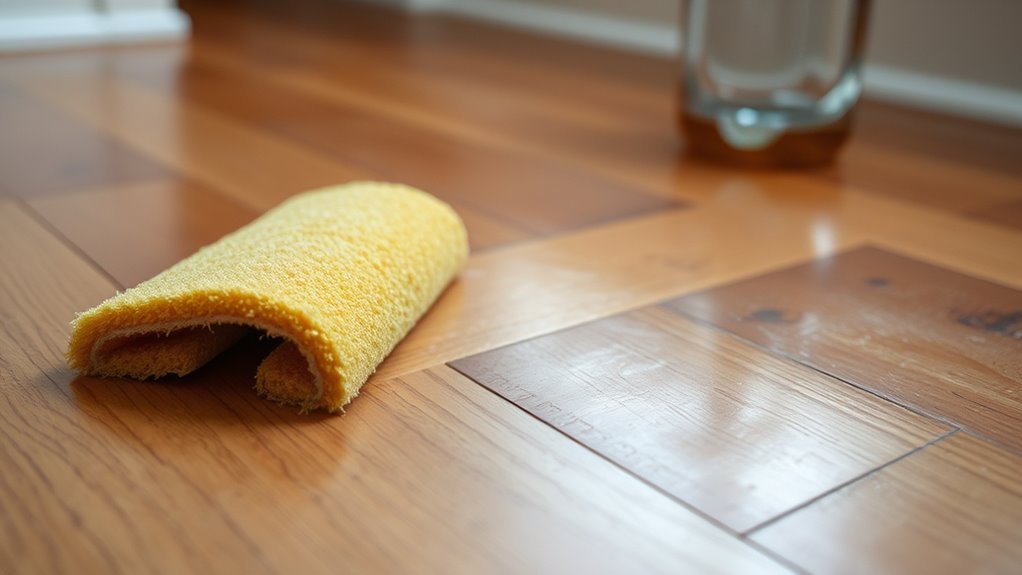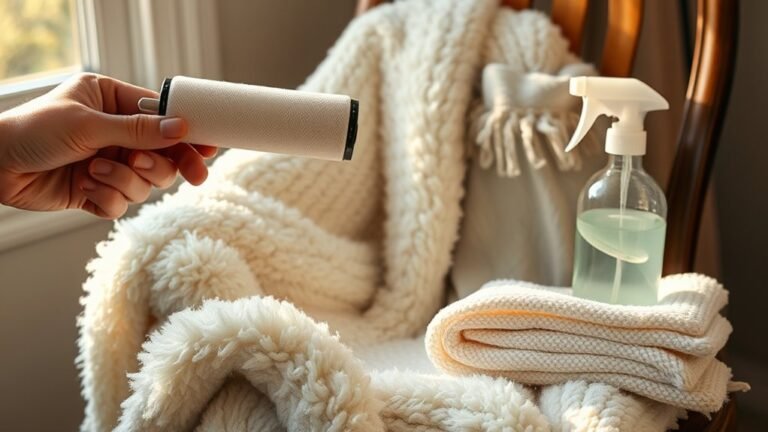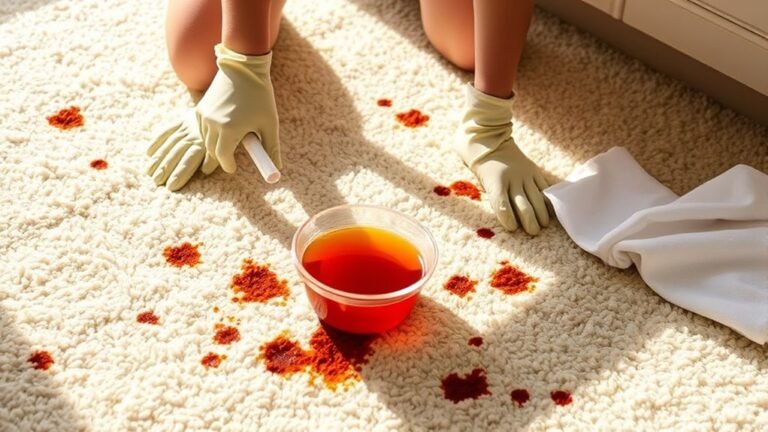5 Common Mistakes People Make When Cleaning Floors
When cleaning floors, you might be using the wrong products that damage finishes or harm surfaces. Skipping sweeping or vacuuming first traps dirt, causing scratches when mopped. Using too much water on hardwood can lead to warping and swelling. Ignoring your floor’s manufacturer guidelines risks costly damage. Plus, abrasive tools like steel wool can scratch and weaken floors. Keep these in mind, and if you want to protect your floors better, there’s more useful info ahead.
Using the Wrong Cleaning Products

Although it might seem easier to grab whatever cleaner you have on hand, using the wrong cleaning products can damage your floors or leave them looking dull. You want to feel free to maintain your space without worrying about costly mistakes. Different cleaning product types are designed for specific surfaces, so understanding surface compatibility is key. For example, harsh chemicals can strip finishes on hardwood, while alkaline cleaners might harm natural stone. Choosing the right product means your floors stay vibrant and intact, giving you the confidence to enjoy your home fully. Don’t let a simple mismatch limit your freedom—take a moment to check labels and match cleaners to your floor type. This small step protects your investment and keeps your floors looking their best.
Neglecting to Sweep or Vacuum First
Before mopping or scrubbing, you need to sweep or vacuum your floors thoroughly. Skipping this step traps dirt and debris, making cleaning less effective and potentially scratching surfaces. Mastering basic sweeping techniques, like using a soft-bristle broom, helps you gather dust efficiently without scattering it. If you prefer vacuuming, choose the right vacuum type for your floor—stick vacuums work well on hard surfaces, while upright models excel on rugs. Using the appropriate vacuum setting prevents damage and guarantees you remove fine particles. By prioritizing sweeping or vacuuming first, you free yourself from stubborn grime and extend your floor’s life. Don’t rush this step; it’s the foundation for a clean, fresh floor that lets you enjoy your space without limitations.
Overusing Water on Hardwood Floors

If you use too much water when cleaning hardwood floors, you risk causing warping, swelling, or permanent damage. Hardwood is sensitive to moisture, and excess water seeps into cracks, leading to water damage that can’t be easily reversed. To protect your floors and maintain their natural beauty, stick to a damp mop rather than a soaking wet one. Also, consider your cleaning frequency carefully—over-cleaning with water can accelerate wear and damage. Instead, clean regularly with a dry or slightly damp method, reserving deeper cleaning for when it’s truly needed. By controlling water use and adjusting your cleaning frequency, you’ll keep your hardwood floors looking great and enjoy the freedom of a beautiful, durable surface without the hassle of costly repairs.
Ignoring Floor Manufacturer’s Guidelines
When you skip over the floor manufacturer’s guidelines, you risk using the wrong cleaning methods or products that can damage your floors. Manufacturer recommendations exist to help you maintain your floors’ beauty and longevity without hassle. To keep your freedom from unnecessary repairs, follow these tips:
- Always check the manufacturer recommendations before trying new cleaning techniques—what works on tile might ruin hardwood.
- Use only approved cleaning products to avoid stripping finishes or causing discoloration.
- Stick to suggested cleaning frequencies to prevent build-up or wear while keeping your floors looking fresh.
Ignoring these guidelines can lead to costly mistakes and lost time. By respecting the manufacturer’s advice, you enjoy clean floors without restrictions or worry, letting you focus on what really matters.
Using Abrasive Tools That Cause Scratches

Although you might think scrubbing harder gets your floors cleaner, using abrasive tools can actually leave scratches that damage the surface. When you’re choosing materials for cleaning, it’s essential to avoid anything too rough, like steel wool or harsh scouring pads, which cause unnecessary scratching surfaces. Instead, opt for soft microfiber cloths or non-abrasive sponges that protect your floors while still lifting dirt effectively. Remember, freedom in your cleaning routine means respecting your floor’s finish—scratches don’t just look bad, they weaken the material over time. So, be mindful and deliberate when choosing tools. The right materials keep your floors looking fresh and give you the liberty to clean confidently without worrying about hidden damage beneath the shine.
Frequently Asked Questions
How Often Should I Deep Clean My Floors?
Imagine your floors like a quiet river—sometimes calm, sometimes needing a powerful sweep to clear the debris. For your deep cleaning frequency, aim for once every three to six months, depending on foot traffic and lifestyle. This balance keeps your floors fresh without overwhelming your freedom. Incorporate floor maintenance tips like regular sweeping and spot cleaning to extend time between deep cleans, giving you more freedom to enjoy your space without constant upkeep.
Can I Use Vinegar to Clean All Types of Floors?
You can use vinegar to clean many floors, but its effectiveness depends on floor compatibility. Vinegar works great on tile, vinyl, and laminate because it cuts grease and grime well. However, you shouldn’t use it on hardwood or stone floors since the acidity can damage the finish or etch the surface. Always test a small spot first so you’re free to clean without worry or damage.
What Is the Best Way to Dry Floors After Cleaning?
Oh sure, just let your floors soak up the puddles like they’re training for a swimming contest! But if you want to actually master drying techniques, grab a microfiber mop or absorbent towel and glide across your floor with purpose. Air drying alone is like waiting for freedom on a leash—it’s slow and unreliable. Take control, speed up floor drying, and enjoy your spotless, streak-free kingdom without the wait or fuss.
Are Steam Mops Safe for All Flooring Materials?
You’re probably wondering if steam mops are safe for all flooring materials. While steam mop benefits include deep cleaning and sanitizing without chemicals, not all floors are compatible. Hardwood, laminate, and vinyl might get damaged by excessive moisture and heat. So, you’ve got to check your flooring compatibility before using one. If freedom to clean efficiently matters to you, just make sure your floors can handle the steam to avoid any damage.
How Do I Remove Tough Stains Without Damaging Floors?
Think of tough stains like stubborn graffiti on a beautiful wall—you want to erase it without scrubbing off the paint. When tackling tough stains, use gentle stain removal techniques like a mix of baking soda and water or a mild detergent. Always test first! For floor protection methods, avoid harsh chemicals and use soft cloths or sponges. This way, you keep your floors safe while reclaiming their natural shine, giving you freedom from worry.






